City Limits recently spoke with several families about what it was like to live at the shelter, the first congregate facility in which the city has placed large numbers of immigrant families with children. All complained about the cold inside the tents, the remoteness, and inaccessibility.

Adi Talwar
A family outside the city’s congregate shelter for immigrants at Floyd Bennett Field at the end of November 2023.Read the Spanish version here.
Some who first went to the shelter at Floyd Bennett Field—a Humanitarian Emergency Response and Relief Center (HERRC), and the first congregate facility where the city has placed families with children in large numbers—decided to leave after seeing how far away it was.
But the site, which opened in mid-November on national parkland along Jamaica Bay between South Brooklyn and the Rockaways, now temporarily houses more than 1,070 people, some of whom told City Limits they remained because they had no other option in the city’s buckling shelter system.
Jairo, who asked that his full name not be used for fear of retaliation, said he and his three children initially rejected the shelter in Floyd, where families sleep on cots in “pod” areas partitioned off from one another.
But after spending the night in a waiting room at the Roosevelt Hotel—the city’s main intake center for immigrant families to apply and reapply for placement in the system—hoping for another space to no avail, they accepted and settled on Floyd Bennett on Nov. 22.
“We have been asking for a stable room, or something more personal,” Jairo said in Spanish. “But they [shelter staff] have told us that they can’t, that they are not helping with that right now because they are not receiving families.”
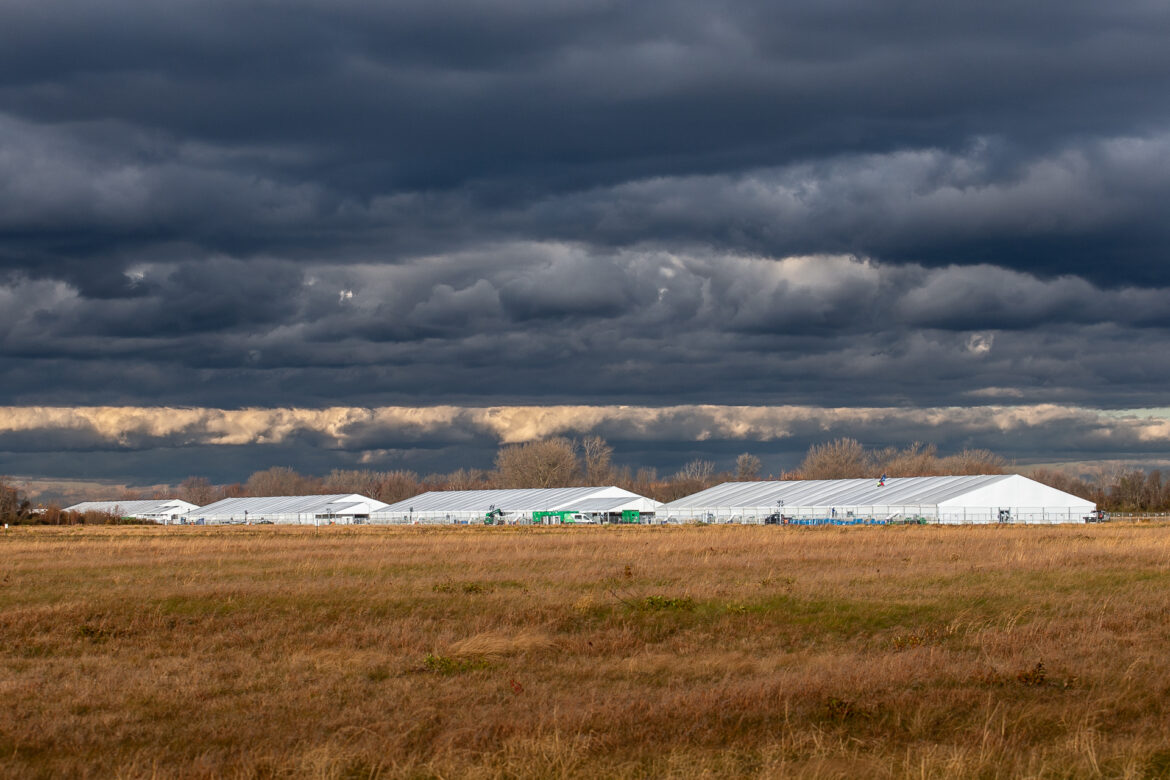
Adi Talwar
A wide shot of the isolated shelter tents at Floyd Bennett Field, where the city is housing immigrant families with children.
With more than 140,000 immigrants arriving in the city since last spring and about 65,000 remaining in the shelter system, officials say it’s run out of space. The city is now limiting the length of time immigrants can stay in shelters, with initial deadlines applying to single men, followed by a 60-day limit for families with children announced two months ago.
While people are allowed to reapply for placement when their stay is up, in recent weeks, hundreds of adult immigrants have camped out on the sidewalk outside the city’s “re-ticketing center” in the East Village in a bid for a bed.
Like other shelters, the Floyd Bennett tent complex has showers, bathrooms, and food distribution areas outside the sleeping tents.
On a visit during the last week in November, City Limits spoke with several families about what it was like to live in this shelter: all complained about the cold inside the tents, the remoteness and inaccessibility.
“We thought it was something else here,” said Jeimy, who asked to withhold her full name. “It’s not the place, but where it’s located. It’s far away from everything. Literally, we are away from everything. And this cold is unbearable.”

Adi Talwar
The city’s HERRC at Floyd Bennett Field at the end of November.
Long commutes
Jesús, an Ecuadorian immigrant who moved to the shelter with his 4-year-old son and wife on Nov. 23, leaves for work at 4:50 a.m. and walks 30 to 35 minutes from the shelter to the Q35 Flatbush Avenue/Ryan Visitor Center, one of the closest bus stops.
According to the mayor’s office, buses operate 24/7 in and out of the shelter complex, but Jesús said he’d not seen them running at the time he needs to leave for work. Breakfast service at the shelter doesn’t start until 6 a.m., and since he has to be at his construction job at 7 a.m. in Brooklyn after a two-hour commute, he skips the morning meal.
“I have seen a group of young people who always go out [at the same time] with me,” Jesús said in Spanish of the lengthy morning walk to the Q35 stop. “I wonder if they go out like me, without eating.”
Three agencies are providing bus routes in and out of the Floyd Bennett Field shelter. The MTA provides a shuttle to and from the Coney Island-Stillwell Avenue subway station from 6 a.m. to 10 p.m. The buses are supposed to run every 90 minutes, though that was not the case during City Limits’ visit, when buses took an average of two hours to complete the route.
When asked, an MTA spokesperson said that the agency had not received any complaints about buses running behind schedule. A spokesman for the mayor’s office said the city is working to ensure that the schedule is maintained.
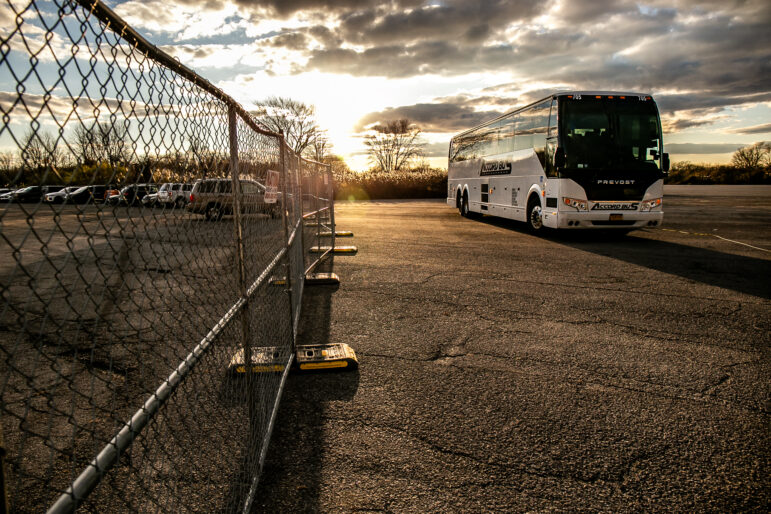
Adi Talwar

Adi Talwar
Three agencies are currently providing bus service to and from the shelter. Photo by Adi Talwar.
Additionally, the Department of Education (DOE) provides two charter buses to drop children off and pick them up during school arrival and dismissal times, from 6 to 10 a.m. and 1 to 6:30 p.m., allowing for after-school program pick-ups. Overnight, from 10 p.m. to 6 a.m., the Department of Corrections (DOC) provides bus service to and from Kings Plaza, about three miles away from the shelter, where there are several bus route options.
Families who spoke with City Limits reported delays at the end of November with the buses that were supposed to take children to school first thing in the morning. When asked, City Hall said it’s working with schools and superintendents to get students assigned buses in a timely manner, and acknowledged additional coordination efforts for students going outside their boroughs.
Children have been given MetroCards to get to and from school, officials added, and in cases of delay, the city offers rideshare to families. About 195 children from the Floyd Bennett HERRC have enrolled in school, DOE officials said.
But advocates argue the far-off location is not a viable option, especially for those with school-aged kids.
“Floyd Bennett Field is not an appropriate place to shelter families with children, and there is no location in the City where it would be appropriate to place kids in a congregate setting,” said Joshua Goldfein, an attorney at The Legal Aid Society, via email. “Since the City is in need of more space for single adults, they should use the tents they have built at Floyd Bennett Field to meet these needs and move the families with children to a more appropriate location.”
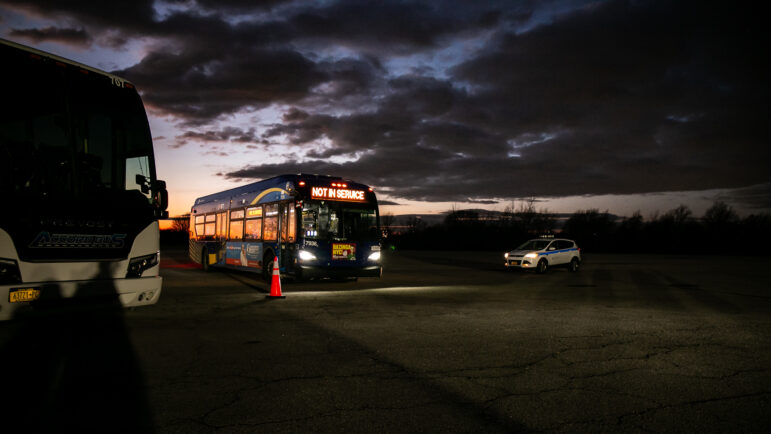
Adi Talwar
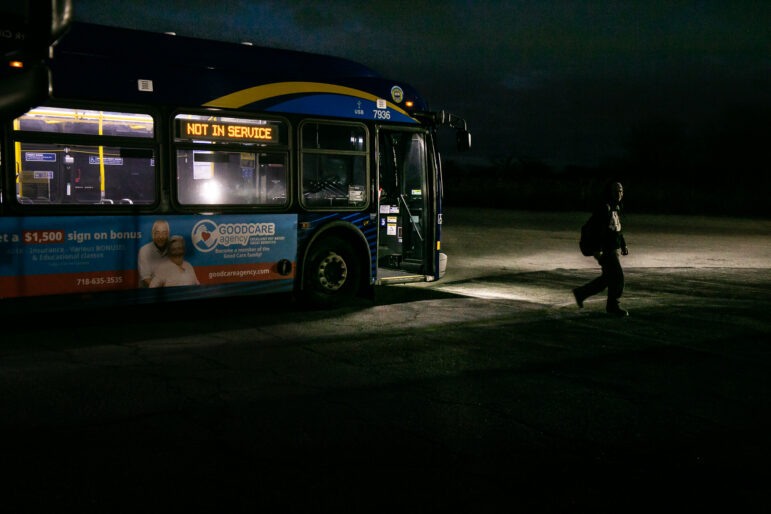
Adi Talwar
Buses outside the tent shelter at night. Photos by Adi Talwar.
The first cold front hits
In one of the southern tents, workers were seen making repairs when City Limits visited the HERRC. Inside the tents themselves, the walls of the dividers meant to separate different families rise only about seven feet, and there are gaps through which one could see into the other “pods,” which some families covered with a blanket for privacy.
On Nov. 28, when the temperature dropped and a Code Blue was issued, drafts seeped through the gaps between the ground and the tent, shelter residents told City Limits. “The [tent] columns were shaking,” said Jesús, 27. “It was scary.”
Jesús had asked the shelter for three more blankets for his son, which he folded in half to make them thicker and warmer, and bought two thermal blankets of his own in preparation. But his son told him he was still cold.
His family’s pod, Jesus said, is about 12 feet from one of the heating ducts, but the air dissipates and cools rapidly. At night, Jesús and his wife each lay down on one side of their son’s cot to warm him up until he falls asleep. “But being alone, he cools down,” he said.
The mayor’s office said Dec. 4 that it had increased heating inside the shelter to maintain an average temperature of 80 degrees, adding that crews check thermostats every hour and that heater ducts were shortened to decrease heat loss.
But the cold extends beyond their sleeping areas, families said.
“They serve it [food] to us, but when you go to pick it up, the food is already cold,” said Jairo, 23. “They have heating, but even so, the food gets cold.”
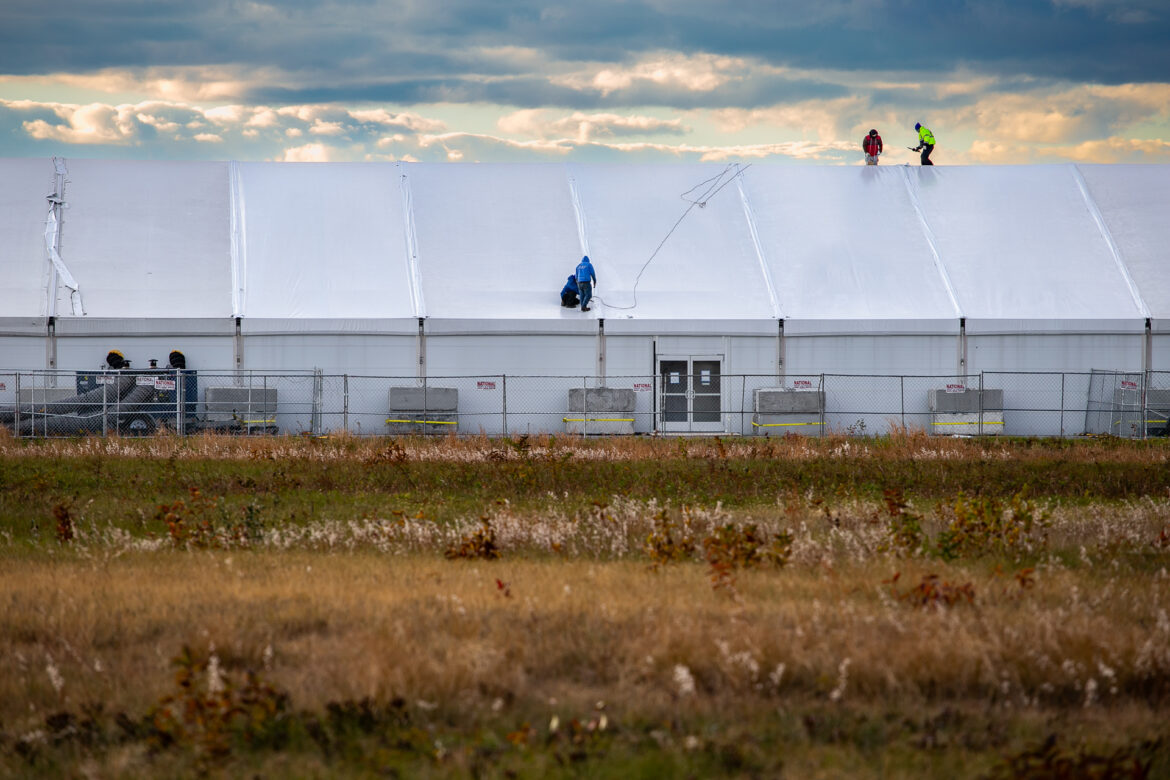
Adi Talwar
Workers on top of the shelter tent roofs at Floyd Bennett Field.Since families can’t cook in these HERRCs, and there are no stores or restaurants nearby to order take-out, access to food is limited. One option is to use the microwave located in the food areas. ”You receive the food and put it in the microwave for two minutes, [and] reheat it,” Jairo added.
On the afternoon of Nov. 27, Jeimy, 35, had on a thin jacket while her son, 16, wore only a t-shirt and sweatshirt and occasionally gave a shivering bounce. They were waiting for the bus to go to the Salvation Army on Nostrand Avenue in Sheepshead Bay, with eight $25 Salvation Army vouchers to buy appropriate winter clothing.
Through partnerships, the Salvation Army has been providing immigrants with vouchers for up to $75 per person, with a maximum of $200 for larger families, which they can redeem at any Salvation Army thrift store in the region.
As of Nov. 30, explained Salvation Army Integrated Marketing Manager Rebecca Smoot, 135 families representing 270 adults and 272 children have received vouchers at Floyd Bennett Field as part of its migrant clothing program.
“With winter approaching, cold-weather items such as shoes, long pants, coats, gloves, and extra changes of clothes are popular,” she said. “Vouchers are good for 90 days upon issue, and once they are redeemed at one of our Thrift Stores, the city contractor who issued the voucher reimburses The Salvation Army.”
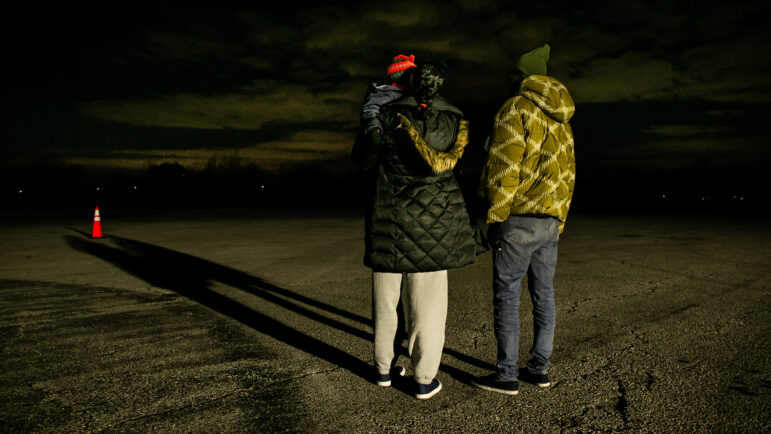
Adi Talwar
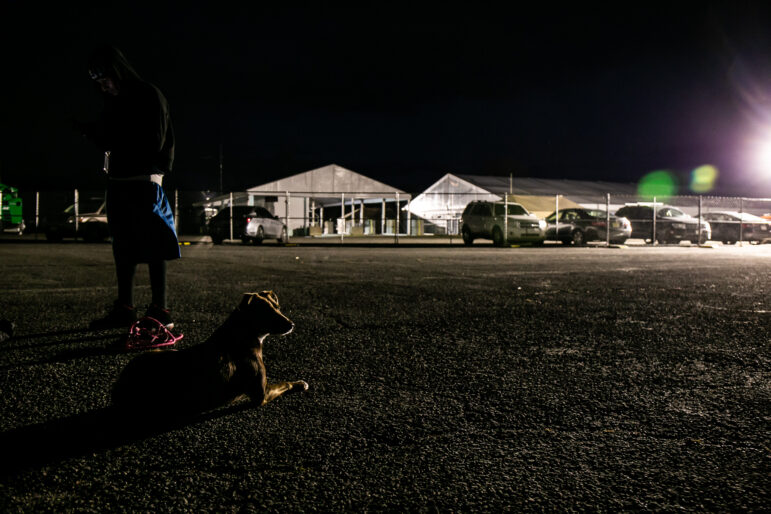
Adi Talwar
Scenes after dark at the Floyd Bennett shelter. Photos by Adi Talwar.
When the bus arrived, Jairo took it, but Jeimy and her son went back into the tent because they could not stand the cold. As night fell, other families took their emotional support dogs out for a walk—allowed at all humanitarian centers, according to the City Hall, which explained that the animal should be declared during the intake process and requires a letter of need from a provider.
“Coming to this country has been difficult,” Jesús admitted, “In one part I am fine, I’m with my family. I am no longer alone. He [my son] gives me the energy to move forward, but in another part, I also think that they do not deserve to be in this place; they are getting very cold.”








